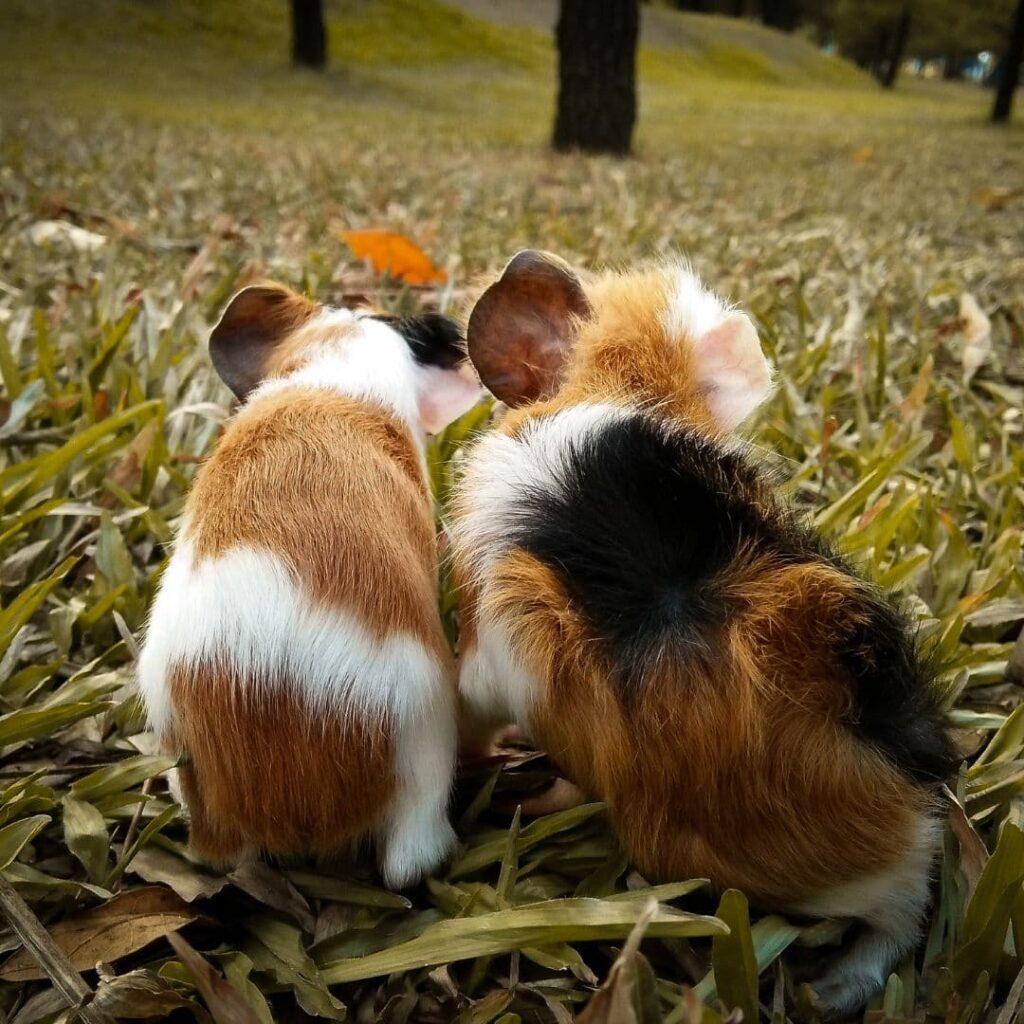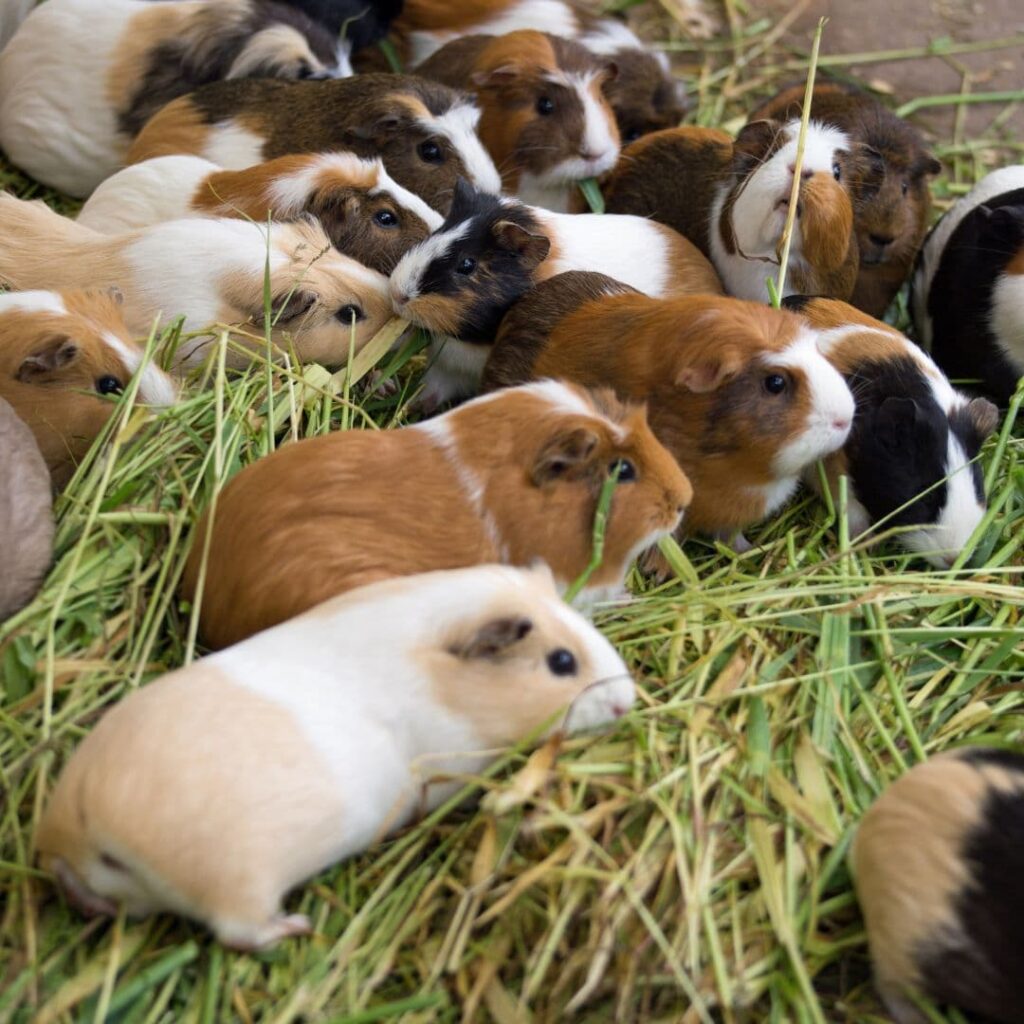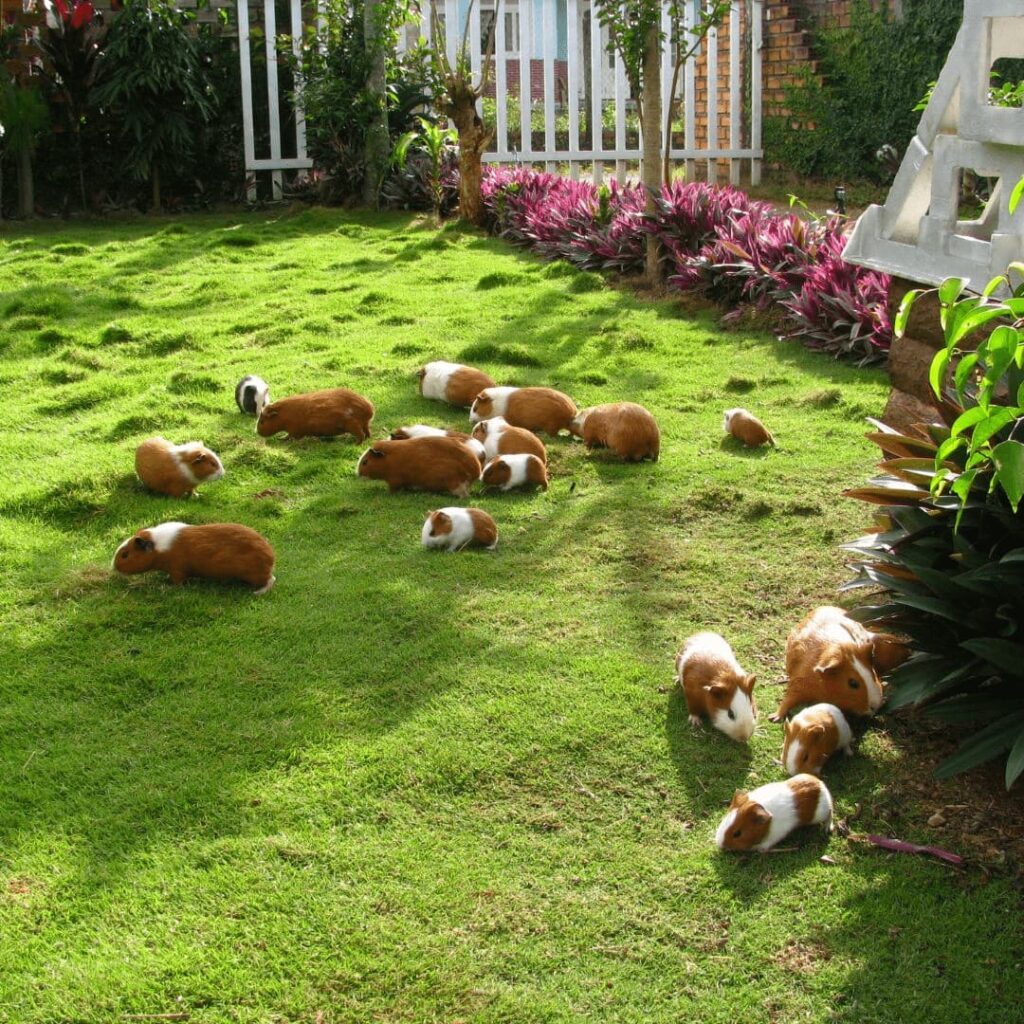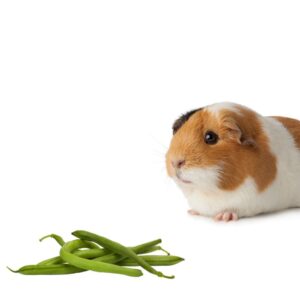We all agree that guinea pigs are great pets, and we know they’re social animals. But to answer the question of how many guinea pigs should you get, there are some critical factors to consider first:
- Living space: How much space do you have? Guinea pigs need sufficient space for exercise and mental stimulation. You should provide at least 7.5 square feet of cage space for one or two guinea pigs, with additional room for each extra piggy.
- Time: How much time do you have for your guinea pigs? They’re gentle, caring, and affectionate animals who love companionship and socialization with other piggies and humans.
- Budget: Do you have enough budget? Guinea pigs must have their cage/hutch, plenty of fresh vegetables and fruit, high-quality nutrient pellets, bedding, and toys. You’d have to replace these consistently to ensure the well-being of your piggies.
- Vet bills: Will you be ready for the necessary vet bills? Considering how delicate and high-maintenance pets guinea pigs can be, you should prepare for regular vet check-ups and potential treatments.
Based on your answers and our guide, you should have an exact number in mind, so let’s get to it.
Table of Contents
What Is the Optimal Number of Guinea Pigs?

The minimum number of guinea pigs that you should get is two, but it is generally recommended that you get three or more. This will help ensure that your guinea pigs have plenty of interaction and stimulation, reducing the risk of loneliness and boredom.
Here are some of the benefits of keeping multiple guinea pigs:
- Guinea pigs will be more active and playful.
- Guinea pigs will be less likely to become stressed or depressed.
- Guinea pigs will be less likely to develop behavioral problems.
- Guinea pigs will have someone to cuddle with and keep them warm.
Understanding the Common Guinea Pig Combinations
Depending on their genders, it may be difficult for some guinea pigs to live together. This is why it’s important to understand the most suitable combinations.
Let’s look at some of the most popular guinea pig combinations you should opt for.
Two or More Sows (Female Guinea Pigs)
Female guinea pigs, or sows, are significantly less aggressive than males (boars). Generally, a pair of sows will cohabitate well, and it’s one of the most popular and safe combinations people choose.
Pairing them or forming a small group is fine, but remember that some sows will feel much safer if they have a boar to rely on.
Neutered Boar with One or More Sows
A neutered boar can live happily with one or more female companions, offering a balanced mix of genders.
Two Boars (Male Guinea Pigs)
Grouping two boars (or more) can be problematic due to their natural tendency for dominance and territorial behavior. But it’s still manageable, and it’s a more common choice for more experienced piggy parents.
Male guinea pigs may struggle with power and fight for dominance, leading to aggressive behavior and potential injuries. This aggression is especially common during adolescence when hormonal changes can amplify their territorial instincts.
Unlike female guinea pigs, who generally get along well, males may find it challenging to coexist peacefully without careful introduction at the beginning and consistent monitoring.
Here are a few tips on how you can make this combination work:
- Early introduction: Introduce the male guinea pigs at a young age to make sure they start bonding as early as possible – once they get old enough, they might become progressively more aggressive due to increased hormones.
Younger boars are generally more adaptable, making it easier for them to establish the right relationship.
- Spacious living environment: Provide a spacious cage with multiple hiding and cozy, resting areas. And don’t forget to separate food and water to ensure each piggy has his own.
This allows each boar to have its territory, reducing the likelihood of conflicts.
- Neutering: Consider neutering both male guinea pigs. Unfortunately, this is one of the most impactful ways to reduce hormonal aggression and the chances of potential conflicts.
The best time to do it is before they reach their sexual maturnity, which occurs by the time they’re two to three months old.
- Provide distractions: Offer plenty of toys, hiding tunnels, and hidey huts. Boredom can contribute to aggression, so providing mental stimulation can help channel their energy positively and reduce the likelihood of conflict.
- Supervising and interaction: Even though previous safety measures can help, supervising your piggies’s always worth your time.
But be aware that guinea pigs like the dark and are most active during dawn and dusk hours, since they’re crepuscular animals.
How Many Male Guinea Pigs Can Live Together?
The short and simple answer would be two. A male guinea pig is naturally more aggressive than a female one, but they’re still affectionate and kind animals who require companions.
If you decide to keep male guinea pigs, having two of them is better to keep each other company. But remember that they’re a bit more difficult to manage when together and it takes quite some time and effort to ensure they get along well.
However, having more than two boars will most likely become hard to manage and dangerous for piggies, since there’s a high chance they’ll fight and hurt each other.
For a safe,more manageable setup and longer lifespan of your guinea pigs, you should keep no more than two male piggies, especially when starting out.
Introducing Guinea Pigs to Each Other

Properly introducing the guinea pigs to each other, as soon as possible, is one of the most effective ways to ensure your piggies get along.
Here’s are some of the most mandatory steps you should follow to make the bonding process succeed:
- Neutral territory introduction: Start by introducing guinea pigs in a neutral territory, to avoid territorial disputes. They should try to spend time together each day.
The more often you try to group them together, the higher the chance of them getting along.
- Gradual integration: Introduce guinea pigs gradually, starting with short sessions and increasing the time as they become more familiar and comfortable with each other.
Certain body language like indicate happiness in a guinea pig – a good sign your piggies are getting along.
Remember: Patience is key; rushing the process can lead to stress and potential conflicts.
- Separate living areas: In case of conflicts, try to separate their habitat into different living areas and only group your piggies together when you’re available to supervise them.
- Supervised play sessions: Make sure you monitor your guinea pigs when they’re together.
Monitor their initial interactions constantly, looking for signs of curiosity, sniffing, or mild social behaviors. Positive behaviors like relaxed postures, vocalizations, mutual grooming, and shared hiding spots is an excellent sign that your piggies are getting along well.
If they display any kind of aggression, such as chasing or biting, separate them immediately to prevent injuries.
- Health check: Before introduction, ensure both guinea pigs are in good health. A vet check can help identify any behavioral issues that may negatively affect the bonding process.
Neutering Considerations
Neutering is important to consider when grouping up multiple guinea pigs in the same caage/hutch. But you should also be aware of how it can affect your piggies.
Female Guinea Pigs
When it comes to sows, they’re less likely to get into a fight and hurt each other, so there’s no reason for neutering. Also, they’re much more delicate and a serious operation such as neutering can pose several risks for their well-being.
Here are some of the reasons you may want to avoid neutering your female piggies:
- Infections: Neutering, or spaying, female guinea pigs involves a more complex surgery compared to males. The incision site becomes susceptible to infections, posing a significant risk to their health.
And guinea pigs, being sensitive animals, may struggle to combat post-operative infections, making the procedure riskier for sows.
- Post-operative stress: Female guinea pigs are prone to experiencing elevated stress levels after surgery. The recovery period can be challenging as they adapt to changes in their body and overall well-being.
Stress can often negatively affect their immune system, making them more susceptible to illnesses during the critical post-operative phase.
- Hormonal imbalance: The hormonal balance in female guinea pigs is delicate, and spaying disrupts this equilibrium. The surgery alters their reproductive hormones, potentially leading to hormonal imbalances. This disruption can result in various health issues, affecting their behavior, metabolism, and overall physiological functions.
Male Guinea Pigs
While neutering can be helpful when grouping a couple of boars, it’s especially important to do it when there are sows in the same habitat.
Sows experience pelvic bones fusion soon after first nine months of their life, making it extremely risky to give birth to pups. That’s why neutering boars can help prevent uncontrolled breeding, which is complicated and often dangerous for female piggies.
Providing The Right Housing

Providing the right housing is one of the most effective ways to establish a safe environment and ensure harmony among piggies.
So, let’s take a look at some of the best ways to make a proper housing for your guinea pigs.
Indoor vs. Outdoor Cage/Hutch
Considering how sensitive guinea pigs are, it’s best to keep them indoors and occasionally spend quality time with them outside, on fresh air.
Indoor cages provide better temperature control, and they won’t be at potential risk of encountering predators.
However, not everyone has enough space inside – and that’s okay. But be aware that if you decide to keep your piggies outdoors, there are some important safety measures you should take to keep them safe:
- First, there must be a cage or hutch for guinea pigs.
- To keep them warm, you should use extra beddings and blankets.
Pro tip: You can also try to lift the cage/hutch of the ground, placing it on a line of bricks or a box – this will not only keep them warm from the cold ground during chilly seasons, but you’ll also protect them from the moisture and potential mold.
- Place plenty of water bottles or at least try to refill them whenever possible. Guinea pigs are active for about 20 hours a day, so they can easily become dehydrated, especially during summer time.
Location
When selecting an indoor location for your guinea pig’s cage, consider a spot where there’s no draft. Guinea pigs are delicate animals and can easily get sick if exposed to a draft constantly.
So avoid placing their cage near open windows or doors.
Also, during hot summer days, you should avoid exposing your piggies to a direct sunlight since they’re prone to heat stress.
Bedding
When choosing bedding for your guinea pig, prioritize materials that offer both comfort and safety. Naturally, these materials
For example, here are some of the most popular options to consider:
- Fleece: Provides a soft surface, comfortable, easy to clean, and dust-free.
- Cloth: Extra comfortable, easy to clean, and dust-free.
- Paper: A nice alternative option but more expensive. Opt for clean, plain paper materials.
On the other hand, you should stay away from:
- Newspapers: They contain chemicals that are toxic for guinea pigs, such as ink.
- Wood shavings: Popular wood shavings include aspen, cedar, and pine. These types of wood produce essential oils and substances such as phenols, toxic for our piggies.
- Straw: Susceptible to mold, potentially leading to poor hygiene level and infections, often causing sickness.
Pro tip: Remember to regularly change the bedding to ensure a fresh and hygienic living space and reduce the risk of health issues – the frequency should depend on the number of your piggies but try to change it daily.
Temperature
Maintaining the right temperature for your guinea pig is vital for their well-being. While the ideal temperature for them ranges between 65-75°F (18.3°C to 23.8°C), it’s equally important to avoid sudden temperature changes.
Although guinea pigs don’t hibernate, they may exhibit similar behavior called torpor, if they feel too cold. This state allows piggies to preserve their energy and keep their bodies warm enough, but it can gradually progress from low activity level to complete inactivity.
To keep your piggy warm, consider providing a designated area with additional insulation, such as a cozy hideout and beds.
On the other hand, if you’re in warmer climate, monitor for signs of heat stress and introduce cooling methods, like a ceramic tile or a frozen water bottle. You can even use a fan in the room to help your guinea pigs regulate their body temperature effectively.
Noise Level
Guinea pigs thrive in a calm and quiet environment, so it’s critical to consider the noise level in their living space. While they can adapt to routine household sounds, excessive noise could make them stressed.
If your household tends to be noisy, consider placing a blanket or a cover on one side of the cage to create a retreat where your guinea pigs can retreat and feel secure.
Of course, hidey huts and cozy guinea pig beds can be most effective ways to make them feel safe and sound.
If you don’t have any yet, here are some of the high-quality ones that you buy for your piggies:
Vet Q&A
How many guinea pigs should a beginner get?
A beginner should start with a pair of guinea pigs – two. A guinea pig is a social, affectionate, and active animal who needs company of other piggies. That’s why they should never be alone.
However, since guinea pigs are high-maintenance pets, new piggy parents should start with a small number first.
Is it OK to have 4 guinea pigs?
Yes, it’s okay to have four guinea pigs. In fact, they love companionship and enjoy being in groups in general. But keep in mind that males can be aggressive and females piggies often rely on their boars to guide and protect them.
Some of thebest combinations you should consider should be:
- One male and three females
- Two males and three females
Is it better to have 2 male or 2 female guinea pigs?
While the best option is to choose a combination you prefer, having two female guinea pigs is more manageable than having two males. And it’s also much safer for them to live together than two males, since male piggies often tend to fight – if not introduced and raised properly.
My Senior Paws is a participant in the Amazon Services LLC Associates Program, an affiliate advertising program designed to provide a means for sites to earn advertising fees by advertising and linking to Amazon.com. We also participate in other affiliate programs which compensate us for referring traffic.




